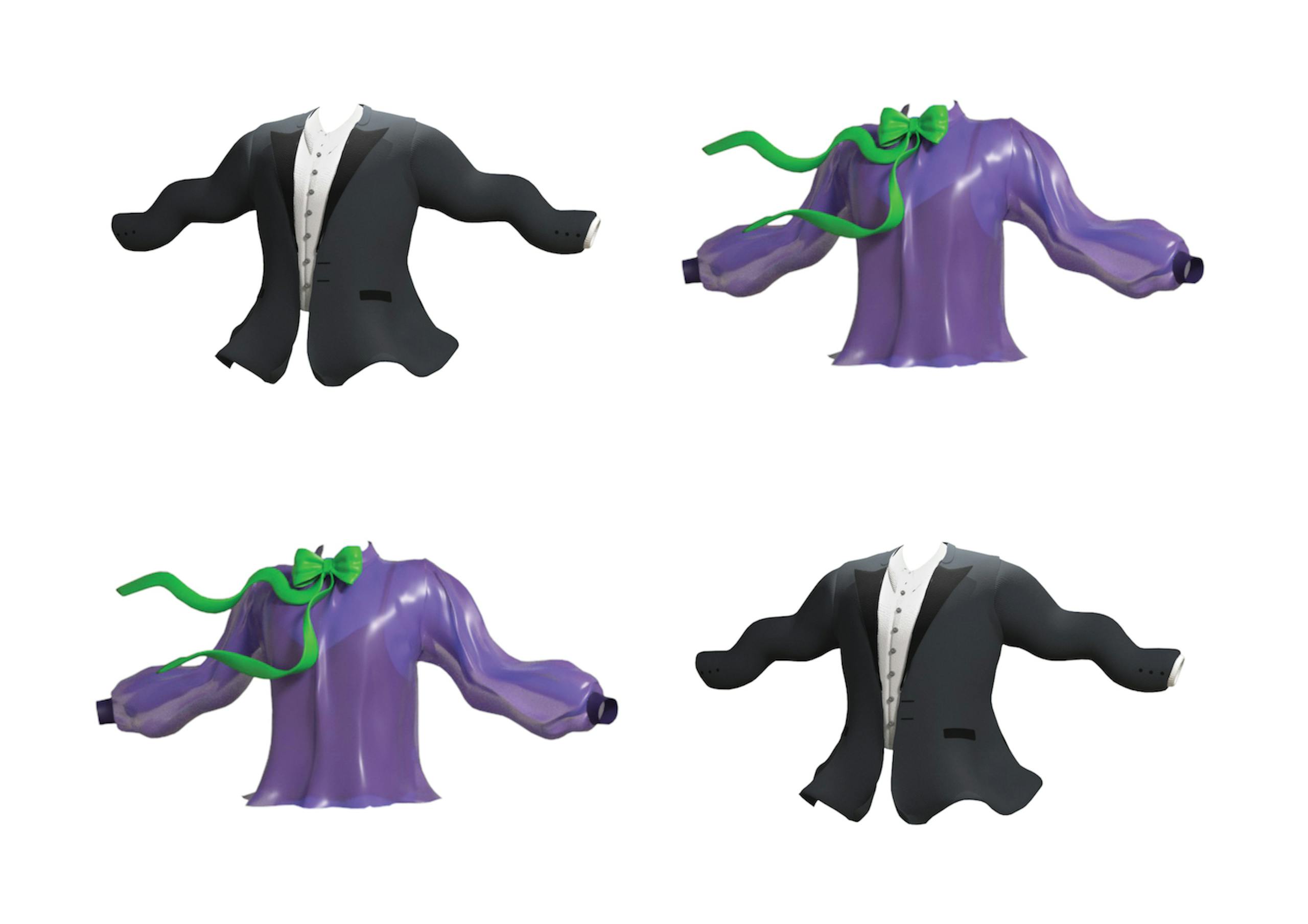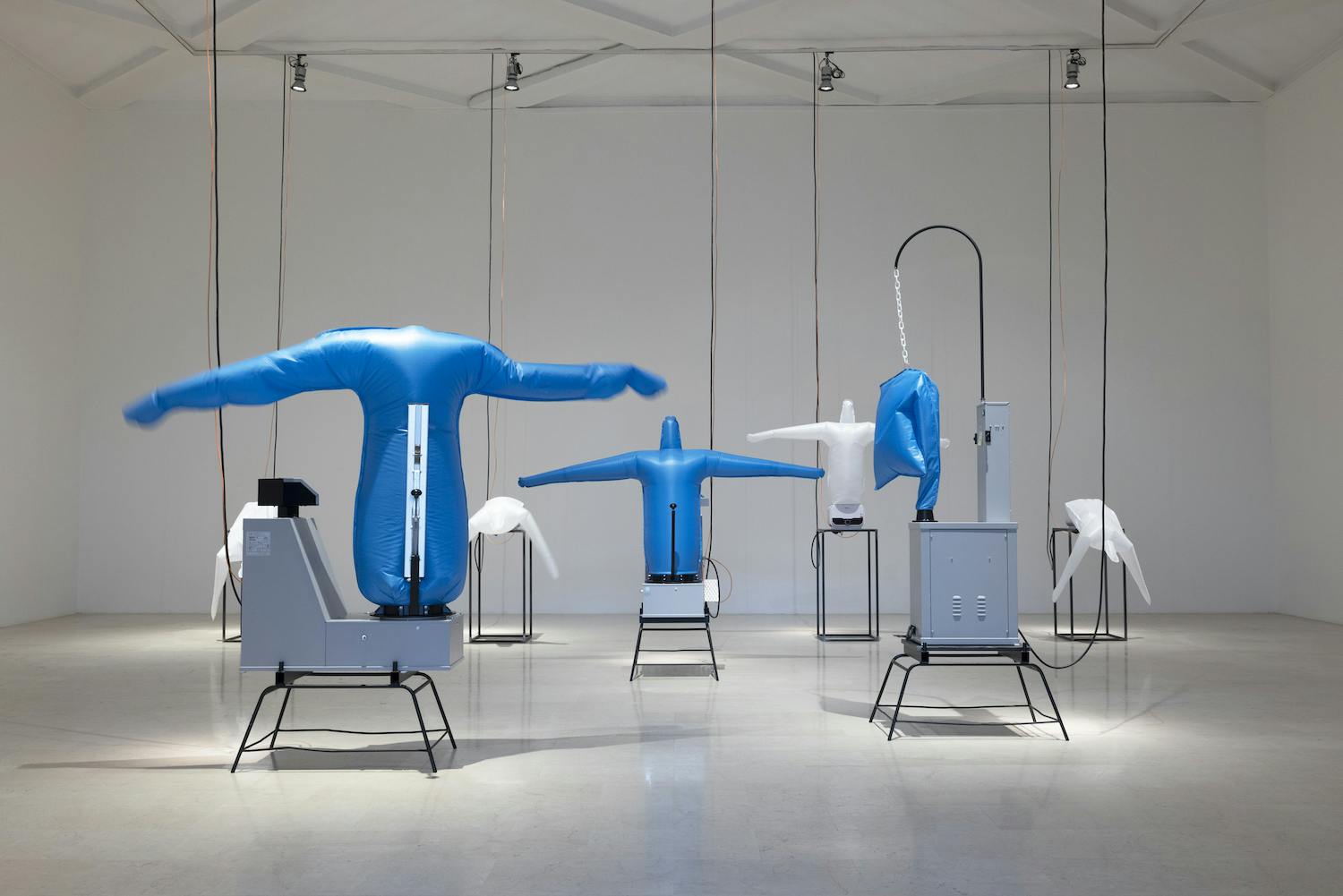

Installation view All Those Stuffed Shirts, photo Andrea Rossetti
All Those Stuffed Shirts: Anna Franceschini Discusses Her "Spinster" Machines
The installation especially designed by Anna Franceschini (Pavia, 1979) All Those Stuffed Shirts is open to visitors until 2 July. This work consists of seven automatic ironing machines called dressmen. As in the case of the artist’s previous works, themes such as automation, a revisited metaphysics, and the idea of cinema as pure movement are expressed through a hypnotic choreography of objects and gestures.
Once ‘hacked’ in their mechanics and ‘re-educated’ through an algorithm, Anna Franceschini’s machines create a choreography modulated by breaths that inflate and deflate bodies of air, following a score that Franceschini has conceived and composed together with artist Matteo Nasini. The combination of all these levels and the loop that is generated bring All the Stuffed Shirts closer to the concept of “celibate machine” than any previous work by Anna Franceschini. This expression dates back to 1952, when Michel Carrouges analysed Duchamp’s Large Glass, linking it to another series of names and forms: the torture mechanism devised by Franz Kafka and implemented through tattooing in In the Penal Colony; the irrepressible automation of Villier de l’Isle’s Adam in The Future Eve; and Raymond Roussel’s text-producing machines in Impressions d’Afrique. However, the archetype of such machines was completely exhausted at all levels in The Bride Stripped Bare by Her Bachelors, Even. Duchamp’s work contains everything: the plan for perpetual motion recited in the form of “litanies”, as in a vicious circle; the complexity of the interconnections, the sterility of the cycle, its autoeroticism, its narcissism and the absolutely self-enclosed nature of the system, in which desire is simultaneously the producer, consumer and reproducer: in other words, the celibate mechanism, the eyewitness.

Anna Franceschini, portrait, photo Andrea Rossetti
During your talk with curator Damiano Gullì and art critic Mariuccia Casadio, you playfully turned the sexual perspective upside down by calling your machines “spinster machines”. I believe that your spontaneous irony actually reveals a lot about these works and more generally about your research.
It certainly reveals that they have been created by a woman who recognises herself as such. Basically, it seemed right to me to semantically redefine the question. Language is very often revealing. The use of certain terms conceals the most treacherous lapses – the short blankets, so to speak, that expose us, naked, to the world. Besides, language is really the machine par excellence. In the story you mentioned, In the Penal Colony, which is a fundamental one for me, the machine inscribes the injunction that has been broken on the convict’s back. It inscribes it so many times on his flesh that it kills him, while the writing becomes increasingly illegible.
During the presentation of All Those Stuffed Shirts, I was struck by your observation that these machines are “tired”. You said it with empathy, as if to give a real identity to these simultaneously animate and inanimate objects. Would you like to elaborate on this aspect?
The identity and possible agency of artefacts is a central theme in my research. Conversely, it is also a way of reflecting on human beings’ actions and emotions. Having said that, I do not believe that my machines actually have consciousness, but they do represent it – they stage it. They draw attention to a population, the population of industrial artefacts, which is quite large (and also noisy!) and which is all around us. On closer inspection, we have far more objects around us, every day, than trees and animals. What is our relationship with them? And their relationship with us? On the other hand, we might speculate a little more on the subject of tiredness. There is a mechanical “fatigue”, in the form of scientifically measurable labour. Machines do indeed get tired: they wear out, they break down, they get sick. After all, they are made up of molecules and atoms as much as we are, and like humans, plants and animals, they are filled above all with void, with tiny particles that revolve around other particles. There, too, everything dances, everything moves and, perhaps, grows tired after a while.

Installation view All Those Stuffed Shirts, photo Andrea Rossetti
Regarding the “fatigue” of mechanical labour today, when many people are preaching “full automation”, in his book Fashion Work (2020, Damiani) curator Jeppe Ugelvig describes the changing nature of artistic work as follows: “Post-Fordist labour takes the mind and creativity as its main tools of production and bears a relation to pleasure, self-fulfilment, and a desire to spend ‘the best part of one’s energy’ furthering one’s own personal enterprise. More so than any other kind of work, this mode resembles that of the bohemian artist, who makes their individual ‘work’ the very central activity of their life – suggesting that in a post-Fordist age, the difference between art work and other work diminishes. When even the fine artist is understood as a flexible entrepreneur – in constant search of new production lines, new markets, new forms of promotion – art is no longer so different from other types of cultural labour, and this becomes abundantly clear in the case of hybrid art/fashion practices.” Do you agree with Ugelvig’s analysis that the modes of expression of fashion, art and other cultural expressions have become increasingly interchangeable practices?
I think they always have been. Just think of the avant-garde, Schiaparelli, Bauhaus. In short, nothing new under the sun. Even Renaissance artists were entrepreneurs, after all. Alternatively, art has been in the service of religion, of the symbolic, but still for a fee. I believe that art is also – perhaps above all work – work in all its senses: late capitalism has only accelerated and amplified certain dynamics underlying artistic practice. The problem for me is not that art is becoming or already is work; if anything, my social concern is that work (whether artistic or not) be fairly remunerated.
Although you have repeatedly used videos and your training includes cinema, most of your works are reified into kinetic sculptures: an idea of cinema made up of reiterated actions, or photographs that refer to set photos where the human figure is both evoked and absent. What cinematic elements, beyond the more usual forms, most inspire your creative process?
Definitely movement, the foundation of cinema (which is also what gives it its name). I actually made a lot more films and videos than kinetic works – I think the ratio is 3:1 or thereabouts. But I have envisaged my films as sculptures from the beginning, trying to bring matter to life through the cinematic device and other mechanisms. I find it incredibly fascinating to be able to make things move, like a sorceress, as if I had super powers: “Ah! Franceschini! The one who makes things move!”

Installation view All Those Stuffed Shirts, photo Andrea Rossetti
All Those Stuffed Shirts also illustrates the ‘permeability’ of your art, which is open to various forms of collaboration and cross-fertilization. Would you remind me of them?
First of all, I should mention the partnership with An Icon, the research group directed by Andrea Pinotti as part of the ERC Advanced Grant project “AN-ICON. An-Iconology: History, Theory, and Practices of Environmental Images”, hosted at the “Piero Martinetti” Philosophy Department of Milan University. Barbara Grespi, a lecturer and expert in media archaeology, invited me to collaborate with the group as an Art based researcher until May of this year. The planned outcome for my fellowship was precisely the exhibition at the Triennale. The group is interested in theories and practices related to immersiveness and the translation of my project from moving image in the classical sense into three-dimensional installation – into a traversable film, an animated movie that does not require a screen – has been, I believe, a fruitful way of commenting on the evolution of the technologies behind the production and enjoyment of moving images.

Installation view All Those Stuffed Shirts, photo Andrea Rossetti
A second form of collaboration has been established with the artist Matteo Nasini. Matteo is a graduate of the conservatory, so it is not uncommon for him to explore sound-related issues in his own practice. The ironing machines that I have displayed can be likened to musical notes. We literally played them through a physical Korg keyboard, which in turn was connected to a virtual keyboard. The peculiarity of the composition lies in the fact that, in this case, the physicality of the ‘keys’, so to speak, cannot be disregarded. As in a Disney animation, in a ‘silly symphony’, the object in question – the keyboard key – comes to life and affirms its own agency, becoming an actor or actant in our story. Sound not only makes itself heard, but is also visible: from being a usable object, it becomes an acting subject. Finally, I have collaborated with Nelly Hoffmann, a designer who is the creator of the Lulli 2020 brand. Nelly and I analysed the characteristics of the original fabrics used for the creation of the mannequins designed for ironing. We decided to try another type of fabric and test how it would react to the flow of air, especially at the moment of deflation. We found what we were looking for in a light ripstop fabric: a perfect combination of lightness, resistance, and expressiveness. Attilio Marinoni, the owner of Sinteco Impianti S.r.l., is one of the leading producers and distributors of this fabric. To our delight, he agreed to become a sponsor of the exhibition. As regards the manufacturing of the mannequins, we did not depart much from the blueprint set by the original design of the machine: we followed the original structure, with a few carefully measured and expertly executed touches added by Nelly. Even the colours used are standard ones in the industry. But, to be honest, the Sinteco swatch book is so wonderful that I am tempted to turn to it for my next work.
In recent art history, various artists have been seduced by cinema to such a degree that they have sought to make real mainstream films, thus experiencing economic and distribution processes of a kind that is usually foreign to artistic practice. This has been the case with various leading figures of the Picture Generation, such as Robert Longo, Cindy Sherman, and David Salle, and then with other artists such as Julian Schnabel, Steve McQueen, and Sam Taylor-Johnson, who did not make cinema simply a passing phase, but a parallel career. Beyond these examples, has it ever crossed your mind to explore that kind of format and thus engage with storytelling?
I would like to stage a story. It would be nice to create a visual adaptation of a novel or short story. I am not interested in being the author of the story, but only in visualizing it, in turning it into images that I like (or kinetic sculptures, or even kinetic sculptures within moving images).
Is there any project (or theme) you are developing at the moment that you would like to tell me about?
Technology is an object of extensive reflection, our relationship with increasingly thinking and (perhaps) desiring machines is rapidly evolving, and there are a lot of films I haven’t seen yet. In short, there is a lot of work to be done!
